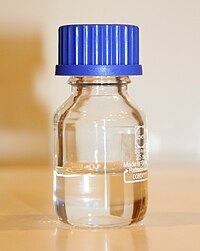Pyridines
|
|
|||
|
|
|||
 |
|||
| Names | |||
|---|---|---|---|
|
Preferred IUPAC name
Pyridine
|
|||
| Other names
Azine
Azabenzene |
|||
| Identifiers | |||
|
3D model (Jmol)
|
|||
| ChEBI | |||
| ChemSpider | |||
| ECHA InfoCard | 100.003.464 | ||
| EC Number | 203-809-9 | ||
| KEGG | |||
|
PubChem CID
|
|||
| UNII | |||
|
|||
|
|||
| Properties | |||
| C5H5N | |||
| Molar mass | 79.10 g·mol−1 | ||
| Appearance | colorless to yellow liquid | ||
| Odor | nauseating, fish-like | ||
| Density | 0.9819 g/mL | ||
| Melting point | −41.6 °C (−42.9 °F; 231.6 K) | ||
| Boiling point | 115.2 °C (239.4 °F; 388.3 K) | ||
| Miscible | |||
| Vapor pressure | 16 mmHg (20 °C) | ||
| Acidity (pKa) | 5.25 (for the conjugate acid) | ||
|
Refractive index (nD)
|
1.5093 | ||
| Viscosity | 0.88 cP | ||
| 2.2 D | |||
| Hazards | |||
| Safety data sheet | See: data page | ||
|
EU classification (DSD) (outdated)
|
Flammable (F) Harmful (Xn) |
||
| R-phrases (outdated) | R20 R21 R22 R34 R36 R38 | ||
| NFPA 704 | |||
| Flash point | 21 °C (70 °F; 294 K) | ||
| Explosive limits | 1.8%–12.4% | ||
| 5 ppm (TWA) | |||
| Lethal dose or concentration (LD, LC): | |||
|
LD50 (median dose)
|
891 mg/kg (rat, oral) 1500 mg/kg (mouse, oral) 1580 mg/kg (rat, oral) |
||
|
LC50 (median concentration)
|
9000 ppm (rat, 1 hr) | ||
| US health exposure limits (NIOSH): | |||
|
PEL (Permissible)
|
TWA 5 ppm (15 mg/m3) | ||
|
REL (Recommended)
|
TWA 5 ppm (15 mg/m3) | ||
|
IDLH (Immediate danger)
|
1000 ppm | ||
| Related compounds | |||
|
Related amines
|
Picoline Quinoline |
||
|
Related compounds
|
Aniline Pyrimidine Piperidine |
||
| Supplementary data page | |||
|
Refractive index (n), Dielectric constant (εr), etc. |
|||
|
Thermodynamic
data |
Phase behaviour solid–liquid–gas |
||
| UV, IR, NMR, MS | |||
|
Except where otherwise noted, data are given for materials in their standard state (at 25 °C [77 °F], 100 kPa).
|
|||
|
|
|||
| Infobox references | |||
Pyridine is a basic heterocyclic organic compound with the chemical formula C5H5N. It is structurally related to benzene, with one methine group (=CH−) replaced by a nitrogen atom. The pyridine ring occurs in many important compounds, including azines and the vitamins niacin and pyridoxine.
Pyridine was discovered in 1849 by the Scottish chemist Thomas Anderson as one of the constituents of bone oil. Two years later, Anderson isolated pure pyridine through fractional distillation of the oil. It is a colorless, highly flammable, weakly alkaline, water-soluble liquid with a distinctive, unpleasant fish-like smell.
Pyridine is used as a precursor to agrochemicals and pharmaceuticals and is also an important solvent and reagent. Pyridine is added to ethanol to make it unsuitable for drinking (see denatured alcohol). It is used in the in vitro synthesis of DNA, in the synthesis of sulfapyridine (a drug against bacterial and viral infections), antihistaminic drugs tripelennamine and mepyramine, as well as water repellents, bactericides, and herbicides. Some chemical compounds, although not synthesized from pyridine, contain its ring structure. They include B vitamins niacin and pyridoxal, the anti-tuberculosis drug isoniazid, nicotine and other nitrogen-containing plant products. Historically, pyridine was produced from coal tar and as a byproduct of coal gasification. However, increased demand for pyridine resulted in the development of more economical methods of synthesis from acetaldehyde and ammonia, and more than 20,000 tonnes per year are manufactured worldwide.
...
Wikipedia





